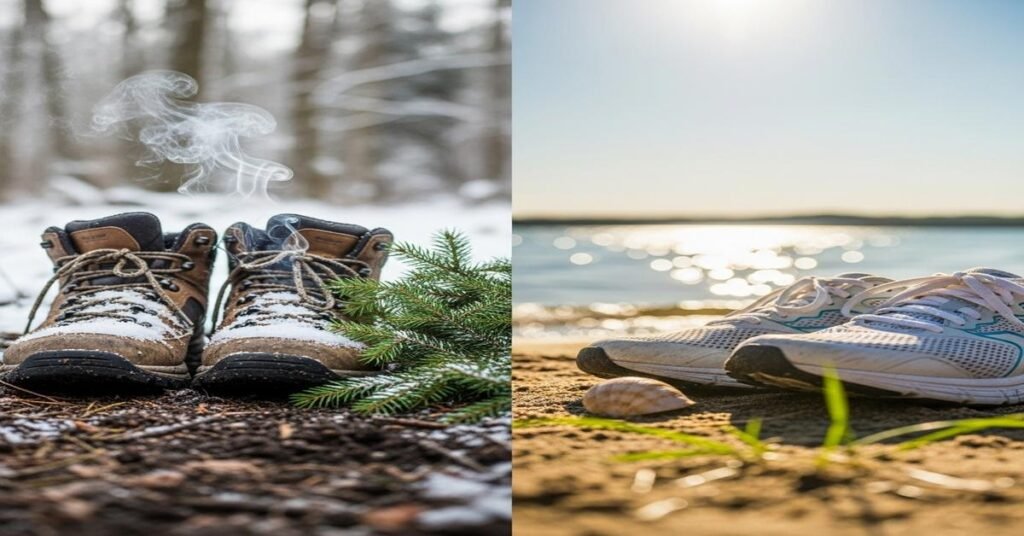Swapping jewelry by season is more than a style move. It adapts pieces to fabric weight, skin exposure, temperature, and care needs. In winter you want pieces that feel grounding next to thick knitwear and cold skin. In summer you want pieces that lift an airy wardrobe and tolerate sweat, salt, and sun. Below are practical swap sets and clear reasons why each change makes sense. I include metal and gemstone specifics, common sizes, and quick care notes so you can swap with confidence.
What “grounding” and “uplift” mean in jewelry
Grounding pieces are visually weighty, textural, and warm-toned. They anchor layered clothing and stand up to heavy fabrics. Metals: 14k or 18k yellow gold, 950 platinum, or oxidized sterling silver. Stones: deep sapphires, garnets, cognac diamonds, or matte finishes. Sizes tend to be larger — think 0.5–2.0 ct centers or chains 3–6 mm wide.
Uplift pieces are light, reflective, and often cooler in tone. They brighten summer outfits and sit comfortably against bare skin. Metals: 14k white gold (often rhodium plated), 14k or 18k yellow or rose in thin gauges, or sterling silver with a clean finish. Stones: aquamarine, peridot, light sapphires, freshwater pearls, or small brilliant diamonds (0.05–0.5 ct). Chains 0.8–1.8 mm and minimal hoops are common.
Practical reasons behind seasonal swaps
- Layering and proportion: Thick sweaters need proportionally larger necklaces and rings so pieces don’t disappear. Thin linen needs delicate pieces that don’t snag.
- Comfort: Heavier chains and chunky rings sit better over wool. In heat, thin pieces reduce chafing and sweat buildup under jewelry.
- Durability: Rhodium plating on white gold can wear faster with salt and sweat. Heavier solid metals like 14k gold or platinum handle winter abrasion better.
- Color temperature: Warm metals (yellow, rose) complement earth tones and jewel tones common in winter. Cool metals (white gold, silver) pop against white, pastels, and bronzed skin.
- Care: Silver tarnishes faster in humid, salty summer air. Store silver separately in anti-tarnish pouches and switch to gold or platinum when traveling to beaches.
Swap set examples — real, wearable recipes
-
Everyday Winter Grounding
– Necklace: 4–5 mm 14k yellow gold curb or figaro chain, 45–50 cm. A weighty chain reads through wool.
– Ring: 6–8 mm signet or dome ring in 18k yellow or platinum 950. Prefer solid metal for warmth and durability.
– Earrings: 6–8 mm stud with 0.25–0.50 ct deep sapphire or cognac diamond, set in yellow gold. The darker stone anchors the face.
– Bracelet: 4–5 mm gold link or thick leather wrap with a gold clasp. -
Formal Winter (evenings)
– Necklace: 16–18″ opera or princess necklace with 1–2 ct center pendant (6.5–8 mm stone) in warm-toned halo for presence under a coat.
– Earrings: Drop earrings with 0.75–1.5 ct pear or cushion stones; gold settings with open backs to let light in.
– Ring: Cocktail ring with a 1–2 ct colored stone (garnet, emerald) in a substantial setting to survive coat handling. -
Everyday Summer Uplift
– Necklace: 0.9–1.3 mm 14k yellow or white gold chain, 40–45 cm. Add a 0.10–0.30 ct pendant (3–5 mm) — subtle and light.
– Ring: Thin bands 1.5–2.5 mm in either 14k yellow or rose. Stack two for interest.
– Earrings: 20–30 mm thin hoops (1 mm wire) or 3–4 mm bezel-set studs with aquamarine or diamond melee (0.05–0.20 ct each).
– Bracelet: Slim bangle 2–3 mm or a delicate chain with a small charm. -
Beach/Active Summer
– Necklace: Short, plated or solid 14k chain under clothing or tucked — consider steel or titanium if you swim often.
– Earrings: Small studs only; hoops and dangles can catch or lose.
– Ring: Remove rings if swimming in chlorinated or saltwater. For a safe option, wear a silicone band or a plain 2–3 mm titanium/gold band you don’t mind getting wet.
– Gem choices: Corundum (sapphire/ruby) and diamond resist heat and sunlight; avoid delicate opal or pearl for beach days.
Metal and stone specifics to guide purchases
- Gold karat: 14k = 58.3% gold, 18k = 75% gold. 14k is tougher for everyday wear; 18k is richer in color but softer.
- Platinum: Usually 950 (95% Pt). Heavier and hypoallergenic. Great for winter rings and heirloom pieces.
- Rose gold: Warmer due to higher copper. Good for grounding looks; still 14k or 18k by gold content.
- White gold: Often rhodium plated. Plate wears with friction, sweat, and salt; expect replating every 1–3 years for active wearers.
- Pearls and opals: Sensitive to chemicals, sweat, and sunlight. Keep them in summer rotation only for short wears and avoid water exposure.
Simple swap and storage routine
- Schedule swaps: do a full change each season or every 6–8 weeks if your climate is variable.
- Store winter pieces in padded pouches to avoid chain kinks. Use anti-tarnish strips for sterling silver.
- Before travel, leave delicate stones and plated pieces at home. Pack heavy-duty pieces (solid gold, platinum) in a small travel roll.
- Quick care: rinse off salt or chlorine immediately and dry. For rhodium-plated white gold, avoid harsh cleaners—use mild soap and a soft brush.
Seasonal swapping is a small habit with big payoff. It keeps pieces looking right with your clothes, protects vulnerable metals and stones, and makes dressing feel intentional. Start with one set (necklace, ring, earrings) and expand as you notice the comfort and style difference.
I am G S Sachin, a gemologist with a Diploma in Polished Diamond Grading from KGK Academy, Jaipur. I love writing about jewelry, gems, and diamonds, and I share simple, honest reviews and easy buying tips on JewellersReviews.com to help you choose pieces you’ll love with confidence.

